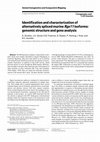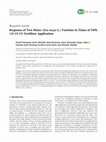Papers by Dr. Muntala Abdulai
Indian Journal of Agricultural Research, May 23, 2024
Agricutural science digest/Agricultural science digest, May 21, 2024
Cogent food & agriculture, Apr 11, 2024

Crop Protection, Feb 1, 2017
The RGS proteins comprise a large family of proteins which were recently identified as negative R... more The RGS proteins comprise a large family of proteins which were recently identified as negative Regulators of G-protein Signaling. They have been shown to act as GTPase Activating Proteins (GAPs) towards the G• subunits of heterotrimeric G-proteins. In addition to this GAP activity, which has been shown to occur through the RGS domain, RGS proteins are likely to possess other functions due to the existence of other domains in these molecules (De Vries and Farquhar, 1999; Hepler, 1999). Here, we report the molecular characterization of the murine Rgs11 gene. The gene encodes a protein with high homology to human RGS11 (79.9 %), containing conserved DEP (Dishevelled/EGL-10/Pleckstrin) and GGL (G protein Á-like) domains. The gene is comprised of at least 13 exons, spanning 8-9 kb. Spliced transcript variants were identified which are co-expressed with 5A3, a transcript that contains the largest ORF. Expression of mouse Rgs11 was found to be restricted to specific tissues with a unique pattern of expression observed in brain.
International Journal of Agriculture and Biology, 2020

Crop Protection, Dec 1, 2016
Watermelon (Citrullus lanatus (Thunb.) Matsum. & Nakai) is an important plant in the family Cucur... more Watermelon (Citrullus lanatus (Thunb.) Matsum. & Nakai) is an important plant in the family Cucurbitaceae. Didymella bryoniae (Auersw.) Rehm [anamorph Phoma cucurbitacearum (Fr.) Sacc.] is the causative agent of gummy stem blight (GSB), a disease affecting members of the family Cucurbitaceae. Watermelon seedlings showing varied degree (20e90%) of suspected GSBs were collected from seedling companies in Antalya province, Turkey. The symptoms included angular water-soaked lesions, which turned tan over time; defoliation; dry, pale green stem; stem necrosis; gummy exudates; wilt; and the eventual death of the upper parts of the seedling plants. The growth of the fungal isolate in vitro showed white aerial and olivaceous mycelium, and olive to dark green or black substrate mycelium at the latter period of fungal growth. The colony surface was rough and undulated. The conidia were round-ended, cylindrical, monoseptate, and hyaline. The conidia ranged from 6.4 to 13.6 mm in length and 3.69e4.68 mm in diameter. The isolates were subjected to PCR using three primers, namely, DB-F3/DB-R3, GSBF1/GSBR1, and ITS1/ITS4, which produced fragment sizes of approximately 120, 780, and 560 bp, respectively. The real-time PCR using DB-F3/DB-R3 primer and SYBR Green fluorescence dye produced positive result for the samples tested. The D. bryoniae isolate was pathogenic to all the four different cucurbits tested and were consistently re-isolated from the diseased seedlings confirming their pathogenic status and thereby satisfying Koch's postulates. This is the second report confirming the presence of D. bryoniae in Turkey after its first detection in cucumber in 2015.

European Journal of Plant Pathology, Oct 16, 2017
Carob (Ceratonia siliqua L.) leaves showing suspected symptoms of Ceratonia Blight disease were c... more Carob (Ceratonia siliqua L.) leaves showing suspected symptoms of Ceratonia Blight disease were collected from both wild and domestic carob plants at various locations in the province of Antalya in Turkey. The fungus growing on culture medium started as white-grayish airy mycelium at the margin with clear light to dark green inner zonation radiating from a common center. Dark brown conidia in chains were observed ranging in sizes from 5 to 35 μm. The conidia surface was smooth to verruculose, slightly constricted with 4–6 transverse septa; the lower part of each portion had one or two longitudinal septa. The conventional PCR was conducted based on the beta tubulin gene and ITS region, which resulted in fragment sizes of 184 bp and 346 bp, respectively. The amplified PCR products were sequenced aligned and BLAST analysis showed 100% homology for the two genes with other strains from the GenBank nucleotide database. The isolates also tested positive with SYBR Green fluorescence dye using Real-Time PCR. The results of the disease incidence recorded across the fields ranged from 10 to 100% on both wild and domesticate carob plants. The putative pathogen was pathogenic on the inoculated carob plants and was consistently re-isolated from the symptomatic plant leaves and thereby satisfying the Koch’s postulates. Based on our knowledge, this is the first report implicating Alternaria alternata for causing Ceratonia Blight disease in Turkey.

SSRG international journal of agriculture & environment science, Feb 25, 2020
Taro leaf blight (TLB), a major disease of taro plant caused by Phytophthora colocasiae, a pseudo... more Taro leaf blight (TLB), a major disease of taro plant caused by Phytophthora colocasiae, a pseudo-fungus, and it occurs in many taro producing regions, especially in the southern part of Ghana. In the year 2019/2020, a survey was carried out in the Bono Region to determine the incidence and the severity of the disease in various taro fields. Infected samples were collected and the pathogen was isolated using potato dextrose agar (PDA). The pathogen was identified as P. colocasiae based on morphological characteristics. Naturally infected taro leaf and petiole samples were physically assessed and computed using the following formulae: Percentage incidence was equal to the number of infected plants over the total number of plants in a visited field/plot, multiplied by 100. The disease severity was calculated and scored on a 5-point scale as follows: Area of leaves infected over the total area of leaves, multiplied by 100. The results showed a widespread occurrence of the disease with varied degree of severities. Though, there was no significant difference in the disease incidence between Dormaa-Central (49.43 %) and Sunyani (54.21%) municipalities (P = 0.344), the disease was more severe in the latter municipality where the scores ranged from 1.383-1.705 than in the former municipality with a range of 0.756-1.674. Overall, the incidence and severity of the disease were significantly higher during the rainy period than in the dry period in both munic

European of agriculture and food sciences, May 21, 2020
Field studies were undertaken at Offinso in the Ashanti Region of Ghana during the 2015/2016 grow... more Field studies were undertaken at Offinso in the Ashanti Region of Ghana during the 2015/2016 growing season to evaluate growth, root and dry matter yields of an improved cassava variety (Bankyehemaa) treated with poultry manure (PM), NPK 15-15-15 and NPK 23-10-10 fertilizers. The treatment structure was a 3 x 4 factorial, laid out in a Randomized Complete Block Design with three replications. Three levels of fertilizer (600 kg/ha NPK 15-15-15, 600 kg/ha NPK 23-10-10 and 2 t/ha PM) were applied at 6, 8, 10 and 12 weeks after planting. The parameters measured included plant height, fresh and dry shoot weights, number of stems per plant, stem girth, fresh and dry root yields and total dry matter yield. The data collected were subjected to analysis of variance using the Genstat Statistical package. Main effects of fertilizer type and time of fertilizer application on most of the parameters measured were not significant. However, the interaction effects of the two factors were significant in all the parameters measured. Vegetative growth of Bankyehemaa increased when mineral fertilizers were applied earlier than 12 weeks after planting. The highest fresh and dry shoot weights and the biggest stems were produced when NPK 15-15-15 fertilizer was applied at 6 weeks after planting. Plants treated with NPK 15-15-15 fertilizer at 10 weeks after planting were the tallest, while those treated with NPK 23-10-10 fertilizer at 8 weeks after planting produced the highest number of stems per plant. Application of poultry manure at 6 weeks after planting produced the highest fresh cassava root yield of 28.10 t/ha. The highest dry matter yield of 19.80 t/ha was obtained when poultry manure was applied at 12 weeks after planting.

International Journal of Agronomy, Apr 12, 2022
Nitrogen rate and time of application are among the major abiotic factors limiting the productivi... more Nitrogen rate and time of application are among the major abiotic factors limiting the productivity of maize. e research was, therefore, carried out to examine the response of two maize varieties (Omankwa and Pioneer hybrid) to four different times of N : P : K 15 : 15 : 15 fertilizer application during the major growing season in Ghana. e experiment was arranged in a randomized complete block design with eight treatment combinations with three replications. Our findings showed that the two maize varieties responded to the time of fertilizer application differently. e interactive effect indicated that the application of fertilizer during planting produced the highest grain yield (4.7 tons ha −1) of the Omankwa (open-pollinated variety) while the application of fertilizers two/four weeks after planting increased the grain yield (6.5 tons ha −1) of the hybrid. e growth and yield parameters were not significantly affected by the treatment combinations. In order for farmers to obtain good yield, it is recommended that farmers should apply N : P : K 15 : 15 : 15 during planting for the Omankwa variety and 14/28 days after planting for the Pioneer hybrid variety in Ghana.

European Journal of Plant Pathology, Jul 20, 2017
Bacterial blight is one of the major diseases of cassava, caused by Xanthomonas axonopodis pv. ma... more Bacterial blight is one of the major diseases of cassava, caused by Xanthomonas axonopodis pv. manihotis (Xam) Bondar (Vauterin et al.) in Nigeria It induces extensive. necrosis on the leaves, twigs and stems systemically, which accounts for significant yield loss. Field survey for symptoms of cassava bacterial blight (CBB) disease was conducted across ten Local Government Areas (LGAs) notable for cassava production in Osun State. Disease incidence and severity were determined by visual examination and scoring of infected plants. Leaf samples obtained from 60 farmers' fields spread over the ten LGAs during the rainy season of 2016 were bioassayed using polymerase chain reaction (PCR) to detect the presence of the pathogen. Two Xam specific primers, 1525R (5'-AGGAGGTGATCCAGCC-3'). and 27F (5'-AGAGTTTGATC (A/C)TGGCTCA-3') were used to amplify 16s gene in total nucleic acid extracted from diseased leaf samples. Leaf samples from Ife North LGA had the highest incidence and severity of 76.10% and 4.5 respectively of CBB disease. PCR results showed high DNA concentration and presence of Xam in eight LGAs with infectivity varying from mild to highly infected. However, further studies will be required to determine the diversity among Xam isolates in the State in order to elicit appropriate control measures.

Journal of Crop Protection, 2017
The study was conducted to determine the distribution of the common Meloidogyne species in resear... more The study was conducted to determine the distribution of the common Meloidogyne species in research stations and vegetable farms in Ibadan, southwestern Nigeria. Galled roots were collected from inoculum plots of four research stations and two vegetable farms. Identification of species was based on juvenile and female morphological characters and specific SCAR primers for Meloidogyne species. The pathogenicity of M. incognita and M. javanica was evaluated at different inoculum levels on tomato in a screenhouse study. M. incognita was the dominant species encountered in research plots, although it often occurred in mixed population with M. javanica and other unidentified species. Growth parameters such as plant height, number of leaves, and yield responded negatively to increasing inoculum levels for all the cultivars except Small Fry and Celebrity. Both cultivars were categorized as resistant to M. incognita and tolerant to M. javanca. The most popularly grown tomato cultivars, Ibad...

European of agriculture and food sciences, Nov 16, 2020
A survey was conducted in twenty-five cashew (Anacardium occidentale) orchards in five communitie... more A survey was conducted in twenty-five cashew (Anacardium occidentale) orchards in five communities in the Dormaa-Central Municipality of Bono Region of Ghana to assess the incidence and severity of anthracnose, gummosis and die-back diseases on cashew. Cashew diseased samples of leaves, stem, inflorescences, twigs, flowers, nuts and apples showing symptoms (e. g. small, water-soaked, circular or irregular yellow, dark or brown spots or lesions on leaves, fruits and flowers, sunken surface, especially on the apples, blight, gum exudates) were collected for isolation of presumptive causative organism. The pathogen was isolated after disinfecting the excised diseased pieces in 70% ethanol, plated on potato dextrose agar (PDA) and incubated at 28 o C for 3 to 7 days. The identity of the putative pathogen was morphologically and culturally confirmed as belonging to Colletotrichum gloeosporioides species complex using standard mycological identification protocols. The pathogen had varied conidia sizes of between 9-15 up to 20 μm in length and diameter of 3-6 μm. The conidia were straight and cylindrically shaped with rounded or obtuse ends. The septate mycelium was whitish-grey, velvety and cotton-like in appearance from the top. The results confirmed the presence of the pathogen in the orchards with incidence ranging from 6.9% and 14.0% for gummosis and averaged 22.9% for anthracnose infected orchards. The result of the pathogenicity test confirmed the isolates to be pathogenic on inoculated cashew seedlings and were consistently reisolated, thereby establishing the pathogen as the true causal agent of the said diseases in cashew trees and thus completed the Koch's postulate. Index Terms-Cashew tree, Colletotrichum gloeosporioides, anthracnose, die-back, gummosis pathogenicity, Ghana. I. INTRODUCTION Cashew (Anacardium occidentale L.), a commercial golden fruit tree, plays an important socioeconomic role in the Ghanaian agricultural sector. Cashew production is carried out in most parts of Ghana where the average yearly rainfall ranges between 1000-1500 mm. The production of the crop has largely increased in the past decades and it is changing the land use system not only in Ghana, but also in other West African countries. Farmers who were previously
International Journal of Agronomy, Mar 27, 2023
American Journal of Plant Sciences
Mycorrhiza - New Insights [Working Title]
Mychorrizae are indigenous soil fungi that are found associated symbiotically with plant root sys... more Mychorrizae are indigenous soil fungi that are found associated symbiotically with plant root system. They promote growth of the root system by protecting the plant from pathogen attack, acting directly or indirectly as biocontrol agents and offering plant resistance. These group of rhizosphere fungi also benefit from various biosynthetic substances produced by the root of the plant (root exudates). In this chapter, attempt is being made to present a balanced account of the various roles these fungi play in plant protection. This will give our cherish readers the opportunity to appreciate the mycorrhizal fungi as potential biocontrol agents or bioprotectants of soilborne plant pathogens.










Uploads
Papers by Dr. Muntala Abdulai